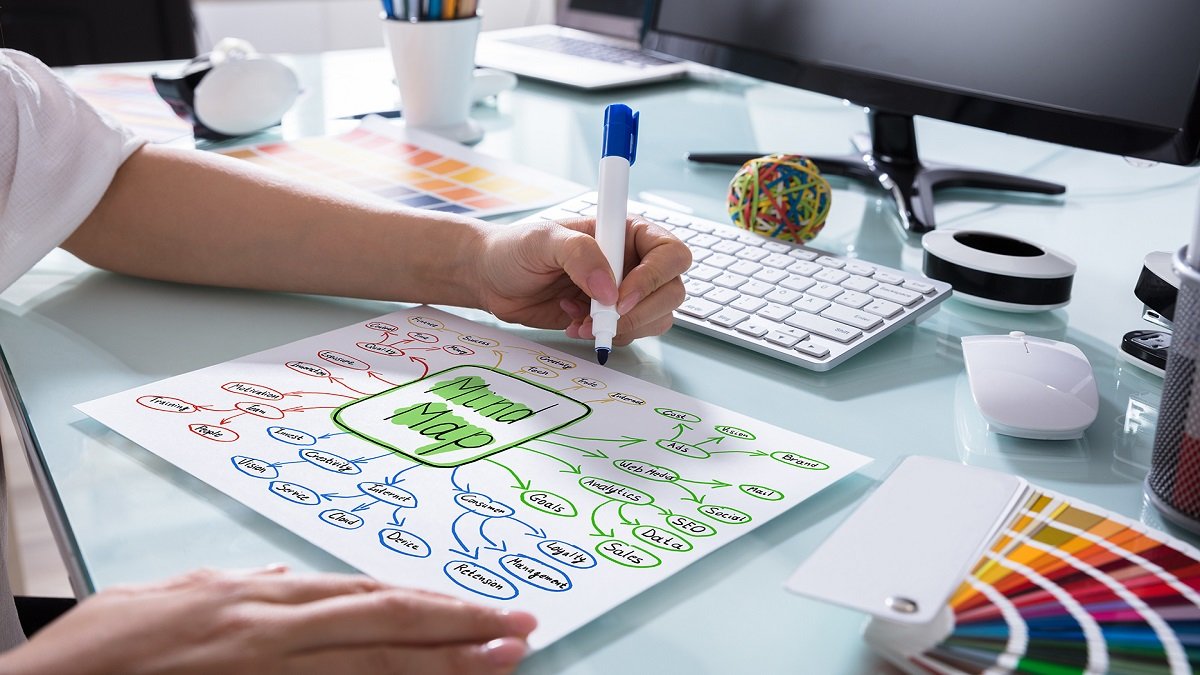Mind mapping is a practice used by people who want to organize their thoughts & along the way, their life. It is very easy. You outline all your thoughts about a selected topic or idea or several ideas. When you note them on paper, you can systematize everything easier & think of solutions you wouldn’t think of otherwise. Therefore, following some Tips on Using a Mind Map can be beneficial.
Tony Buzan first introduced the idea of mind mapping. He was an English author & a consultant, & his innovation improved the lives of many by this point. Their interest showed nearly immediately & people instantly discovered this method’s greatness.
Tips on Using a Mind Map

1. Have Pictures & Images in The Center
A single image can replace a thousand sentences & even an entire paragraph, so you must have those in your mind map. To make it shorter & easier to comprehend & look at, use pictures & images in it, most significantly in its center. This will help you to focus on the key thought.
Use colors and use them adequately. Colors are as good for your brain as images & will help you to focus better, memorize & organize better. The more you use them, the more lively you can make your map of thoughts. Besides, it will help you quickly find the things you are searching for when you go back to the mind map looking for them.
2. Pre-Writing & Writing
Whether you are a professional writer or a school student, maps are an excellent way to organize your ideas, inspiration, & generate new ideas. Online & offline, writers talk about using maps to write anything from routine documents to creative agendas, letters, speeches, reports, essays, assignments & books.
Software-based maps may also contain live links to files, websites, & images – which is very helpful when researching.
3. Make Many Branches & Unite Them
A mind map works best in the following manner: you create many branches, but a few are the main branches & others are sub-branches of those main branches. Connect all of those & remember to connect every branch type to the one before it. Connect the main branch with the vital picture or image, the second-level branch to the first-level branch, & so on.
4. Use It For Brainstorming / Idea Creation
One of the best Tips on Using a Mind Map is while having a brainstorming session. Whether brainstorming for yourself or arranging a meeting with office colleagues, you can use maps to quickly describe a problem, task, or event, collect ideas, formulate criteria to assess the ideas, & discuss ways to execute the chosen idea.
Some mapping software provides a special brainstorming mode to accelerate the collection procedure. Other software (like Freemind) is so user-friendly & quick to create nodes that no special mode is required.
You can also generate a map to produce ideas about nearly any question, project, or problem. Nothing is too dull or too complex to mind map.
5. Use Curved Lines as Your Branches
One of the best Ways to Use Mind Maps is to have curved lines as branches instead of straight ones. Your objective is to use as few words to gather your thoughts as possible. Pictures are helpful, but when you need the wording to brighten things up or present some idea more clearly, use keywords to provide some suppleness.
You don’t need to be an admirer of using mind maps to recognize their significance. Once people use mind maps to organize their time & thoughts, whether for personal or professional reasons, they find it a matchless tool for better & more organized life; with mind mapping, you can do things even if you failed to do them before.
6. Use It For Research
Mind maps can also substitute the older methods of using outlines, card notes, & other note-taking & organizing methods that were taught in schools for many years. There is still some place for notebook apps (such as Evernote or OneNote), & various other information storage systems. Still, no one would put a link to a OneNote page into a map to simplify finding information.
Whether you are doing some “professional” research or “life” research (like finding a good doctor, realtor, mechanic, or college), you can use a mind map to organize the research & reorganize it. As stated earlier, you can enter data into the map you created & add links to other files & websites. Some mapping software will let you add tables, synopsis, & even spreadsheets to your maps.
7. A Tool For Education
Teachers can use mind maps in various ways. You can develop every day, weekly, or semester-long lesson plans on your map. Teachers can also use maps to summarize topics for their classes or help students to use maps to collect ideas or research.
There are various websites, books & software packages mainly for using mind maps in education. Indeed, being a student can be a lifelong engagement. Mind maps can always help.
8. Tool For Decision Making
Mind maps are an excellent tool for the decision-making process: describing the decision to be made, gathering data & testing different solutions, considering the criteria for making the right decision, allotting a numerical score to the criteria, & ultimately making a choice. Combine your map with the supporting objects to defend that decision if inquired about it later.
Tony Buzan, in his book, has included chapters on decision-making for “binary,” two-choice decisions & “polycategoric” (more than two choices) decisions, requiring mapping numerous possible solutions. He used mind maps for both categories.
Utility of Mind Maps
People use mind maps for dissimilar reasons. Some use it in their professional life, others for their personal life. Introducing some management in your life is an intelligent move & more often than not, necessary & unavoidable if you want success. Generally speaking, the most common Tips on Using a Mind Map are:
- Record of completed tasks.
- To-do lists for incomplete tasks.
- Projects & project fails.
- Record of brainstorming sessions.
- Action plans & blueprints.
- Design for projects & work assignments.
- Document management.
- Inventory of resources & tools.
- Daily agendas.
- Workout routine record.
- Diet & Shopping log.
FAQs
Q: Do I need a Mind Map to follow the Tips on Using a Mind Map?
A: You can use a Mind Map in almost any matter; you can have one about this, too.
Q: What are some Best Mind Mapping Software?
A: There are plenty. ConceptDraw, MindManager, Miro, MindMeister & Lucidchart are some of them.
Q: Can I use these software for free?
A: There are many free mind mapping software. Many offers free service but with limited functions.











